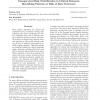Free Online Productivity Tools
i2Speak
i2Symbol
i2OCR
iTex2Img
iWeb2Print
iWeb2Shot
i2Type
iPdf2Split
iPdf2Merge
i2Bopomofo
i2Arabic
i2Style
i2Image
i2PDF
iLatex2Rtf
Sci2ools
72
Voted
ICML
2010
IEEE
2010
IEEE
Unsupervised Risk Stratification in Clinical Datasets: Identifying Patients at Risk of Rare Outcomes
Most existing algorithms for clinical risk stratification rely on labeled training data. Collecting this data is challenging for clinical conditions where only a small percentage of patients experience adverse outcomes. We propose an unsupervised anomaly detection approach to risk stratify patients without the need of positively and negatively labeled training examples. High-risk patients are identified without any expert knowledge using a minimum enclosing ball to find cases that lie in sparse regions of the feature space. When evaluated on data from patients admitted with acute coronary syndrome and on patients undergoing inpatient surgical procedures, our approach successfully identified individuals at increased risk of adverse endpoints in both populations. In some cases, unsupervised anomaly detection outperformed other machine learning methods that used additional knowledge in the form of labeled examples.
Clinical Risk Stratification | ICML 2010 | Machine Learning | Stratify Patients | Unsupervised Anomaly Detection |
| Added | 09 Nov 2010 |
| Updated | 09 Nov 2010 |
| Type | Conference |
| Year | 2010 |
| Where | ICML |
| Authors | Zeeshan Syed, Ilan Rubinfeld |
Comments (0)

